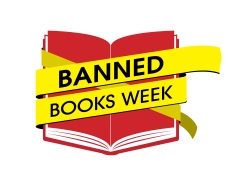311 Reasons to Celebrate Banned Books Week
“Free Speech” is a monthly column by Chris Finan, director of the American Booksellers for Free Expression (ABFE), that shares his personal thoughts and opinions on a broad range of free expression issues; the views expressed do not necessarily reflect those of the American Booksellers Association. Finan welcomes comments and suggestions at [email protected].
Is it time to retire Banned Books Week?
There was obviously a good reason for starting it in 1982. Efforts to remove controversial books from schools and libraries skyrocketed following the election of Ronald Reagan in 1980, an event that encouraged activists to roll back what they perceived as the permissiveness of the 1960s and 1970s. In the mid-1990s, there were almost 800 book challenges per year.
 But the number of reported challenges has fallen. According to the American Library Association, which provides the only national statistics, there were 311 reported attempts to remove or restrict materials from school curricula and library bookshelves in 2014–2015.
But the number of reported challenges has fallen. According to the American Library Association, which provides the only national statistics, there were 311 reported attempts to remove or restrict materials from school curricula and library bookshelves in 2014–2015.
Jack Shafer, a writer for Politico, recently described book challenges as “isolated and rare.” They are a mere “rounding error in our free speech accounting” when you consider there are 22,000 public schools in the United States, he said.
But statistics do not give a full picture of what is going on. The reality is that censorship is still a problem in this country, and most of the victims are kids. Sometimes books are literally taken out of their hands. In Tucson a couple of years ago, school officials entered a classroom and collected books that they then tossed in boxes marked “banned.”
In 2014–2015, there were efforts to censor Young Adult books by Sherman Alexie, Stephen Chbosky, Chris Crutcher, Emily M. Danforth, Barthe DeClements, Cory Doctorow, John Green, Ellen Hopkins, David Levithan, Stephanie Meyer, Jodi Picoult, Marjane Satrapi, and Raina Telgemeier.
Most book challenges fail, but many succeed. The Absolutely True Diary of a Part-Time Indian was pulled from a high school supplemental reading list in Meridian, Idaho; The Miseducation of Cameron Post was removed from the summer school reading list in the Cape Henlopen school district in Delaware. The Fault in Our Stars was taken off library shelves in a middle school in Rancho Cucamonga, California, and eighth graders were not permitted to read Paper Towns in Wesley Chapel, Florida.
When books are banned, kids get hurt. No one knows this better than the authors of the books that are challenged. They reacted strongly several years ago when Meghan Cox Gurdon, who writes about children’s books for the Wall Street Journal, described contemporary YA literature as “a hall of fun-house mirrors, constantly reflecting back hideously distorted portrayals of what life is.”
“Books don’t turn kids into murderers, or rapists, or alcoholics,” Laurie Halse Anderson replied. “Books open hearts and minds, and help teenagers make sense of a dark and confusing world. YA literature saves lives. Every. Single. Day.”
YA literature would deserve defending even it helped only a handful of kids. But YA authors like Anderson, Alexie, Crutcher, Lauren Myracle, Lois Lowry, Robert Cormier, and Judy Blume receive thousands of letters from grateful teens every year.
So there is a lot at stake when someone challenges a book that educators and librarians believe it is important for kids to read.
The problem of book banning is also much larger than the reported number of challenges suggests. ALA’s count is based on reports from librarians and the press, but ALA officials estimate that as many as 80 percent of challenges are unreported.
Recent investigations in two states suggest the number may be even higher. Students at the Missouri School of Journalism used requests under the Freedom of Information Act to discover 51 challenges in Missouri between 2008 and 2012. Only six (12 percent) were reported to the ALA’s Office for Intellectual Freedom. The Texas ACLU used FOIA to uncover 65 unreported challenges in 2011 alone.
Whatever the actual number of challenges, we can be sure that there would be many more if there weren’t people all over the country resisting efforts to ban books. Booksellers have joined teachers, librarians, parents, students, and other concerned citizens in fighting back.
 They are supported by national organizations, including ALA, the National Coalition Against Censorship (NCAC) and the National Council of Teachers of English. The American Booksellers for Free Expression joined NCAC in creating the Kids’ Right to Read Project to assist the fight at the local level, and KRRP is now co-sponsored by the Association of American Publishers and the Comic Book Legal Defense Fund.
They are supported by national organizations, including ALA, the National Coalition Against Censorship (NCAC) and the National Council of Teachers of English. The American Booksellers for Free Expression joined NCAC in creating the Kids’ Right to Read Project to assist the fight at the local level, and KRRP is now co-sponsored by the Association of American Publishers and the Comic Book Legal Defense Fund.
Booksellers have often played an important role in the fight against book banning. Last July, after the local school board banned The Miseducation of Cameron Post, Browseabout Books in Rehoboth Beach, Delaware, began distributing free copies of the book to kids on request.
Most bookstores never have an opportunity to take such a prominent role in a censorship fight — but all booksellers can help carry the message. ABFE is encouraging all members of the American Booksellers Association to mount displays of banned books to make it clear that we are still fighting for the freedom to read. We have recently expanded the distribution of free Banned Books Week kits to make it easier for booksellers to mount their displays.
We don’t really need 311 reasons to celebrate Banned Books Week. What we are really celebrating is the fight for the free speech rights of kids.


